ENCORE: PRO MODIFIED: THE FORMATIVE YEARS
EDITOR'S NOTE - If you're a fan of Pro Modified style racing and wondered how this class came about, we present to you the most extensive history piece ever written. This four-part series was written by CompetitionPlus.com Publisher Bobby Bennett who was there and lived the experience. It's a lengthy read but well worth the time.
READ ALL FOUR PARTS OF THE SERIES …
PART ONE – THE FORMATIVE YEARS
PART TWO - THE MOVEMENT TURNS INTO SOMETHING SPECIAL
PART THREE - THE MOVEMENT IS CHRISTENED AS PRO MODIFIED
PART FOUR - AN ELIMINATOR IS BORN
Originally published 11-12-2009
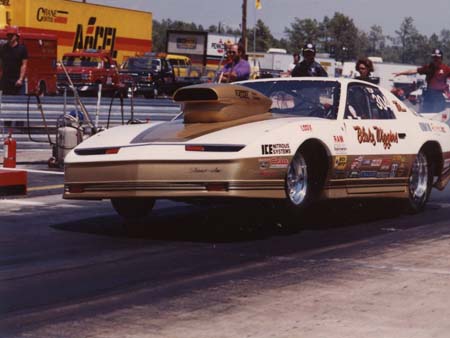 If you’re a Pro Modified fan, March 10 is your Independence Day.
If you’re a Pro Modified fan, March 10 is your Independence Day.
On a Saturday afternoon in 1990, within the small racing hamlet of Darlington, SC., a group of doorslammer racers declared their independence from Top Sportsman eliminator and became the first true professional addition to the drag racing fraternity since 1969 when Jim Tice’s AHRA introduced Pro Stock.
This time it was the IHRA’s opportunity to be the first to introduce a professional eliminator that it had developed and nurtured within the sportsman ranks, and after nine years of weaning was ready to leave the nest and stand on its own.
The battle to debut at the 1990 IHRA Winternationals could have been a hard-fought and determined battle for acceptance except for one thing - the media and the race fans couldn’t get enough of the fast doorslammers racing on the edge of being out of control. Becoming a professional category was a natural progression.
Looking back on that initial introduction, Pro Modified has become more than just another professional category for some. It has become a lifestyle. Websites and magazines bear the name of this class. Dozens of race series exists with the quick doorslammers and in the ultimate show of confidence, one sanctioning body exists because of Pro Modified.
In the next two months, CompetitionPlus.com will present a four-part series chronicling the early years of Pro Modified.
WHERE DID IT BEGIN?

Pro Modified might have debuted in March 1990, but its roots clearly go deeper into the 1980s. Many Pro Modified experts consider the true starting point for the Pro Modified movement as Charles Carpenter’s nitrous-assisted, eight-second run in the fall of 1983 while others say it was Bill
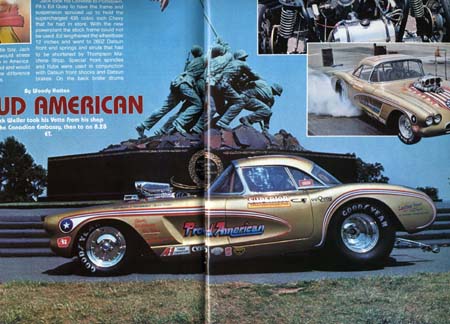 This unheralded blown Corvette belonging to Jack Weller and driven by Funny Car racer R.C. Sherman drew the attention of race fans almost two years before Charles Carpenter fueled the fire of the Pro Modified movement.(Photos by Woody Hatten, Super Stock Magazine)
This unheralded blown Corvette belonging to Jack Weller and driven by Funny Car racer R.C. Sherman drew the attention of race fans almost two years before Charles Carpenter fueled the fire of the Pro Modified movement.(Photos by Woody Hatten, Super Stock Magazine)
Kuhlmann’s 202-mile per hour blast during the 1987 Winternationals.
The groundswell can actually be traced back to 1981 and a former nitro Funny Car driver behind the wheel of a blown doorslammer.
At least, that’s what noted Pro Modified historian and veteran journalist Bret Kepner believes.
History backs up his claim.
Jack Weller might very well have laid the first pebble in Pro Modified’s foundation. Weller fielded a blown 1959 Corvette named “Proud American” driven by R.C. Sherman. The excitement this car generated inspired the mountain motor partial crowd at the IHRA to recognize doorslammers which could run quick without the aid of carburetors and mega cubic inches.
Up until then, the east coast doorslammer afficianados looked at superchargers as something that belonged on the west coast.
“That was the car that stunned everybody,” said Kepner, who was a national event announcer at the time with the then Bristol, Tenn.-based sanctioning body. “It was a return to AA/Gasoline Supercharged, part fuel altered and it was quicker than a Pro Stock. When that car went into the sevens, everyone was stunned.”
The performance of the car got very little media attention. Two years later when Carpenter bolted nitrous oxide onto his all-steel 1955 Chevy and ran 8.3-seconds, only then did the IHRA drag racing community begin to take notice.
The rebellious nature of the mainstream drag racing magazines such as Super Stock & Drag Illustrated [SS&DI] and the upstart Drag Racing magazine from Petersen Publishing threw aside the barriers that had long prevented the IHRA from top billing in their coverage.
The late Steve Collison, former SS&DI editor, grasped a statement uttered by then IHRA Drag Review Photographer Dave Bishop proclaiming Carpenter’s ’55 Chevy, then referred to as a shoebox, as the “world’s fastest ’55 Chevy”, and promptly featured the car in his magazine. His west coast equivalent Dave Wallace, the leader of Petersen’s Drag Racing, followed suit.
The movement for Pro Modified had officially begun and for those in the IHRA fold, Carpenter’s growing popularity enabled them to tie the success of the unheralded Weller Corvette with Carpenter’s unsafe, but quick doorslammer.
“It was kind of a continuation [of what the Corvette had started] but because it got very little media attention, most consider Carpenter to be the guy who started it all,” Kepner confirmed.
Not only did Carpenter serve as an inspiration for others to bolt big nitrous plumbed engines into classic cars but he also served as a defender of the playground then known as Quick Rod. The Quick 32 bracket class was under siege by a growing contingent of big block, Econo-style dragsters. By that time, a gentleman named Robbie Vandergriff, who drove an equally fast 1957 Chevy for Jim Bryant, joined Carpenter in the fight.
The performance of these two cars was enough to inspire IHRA Vice President Ted Jones into action.
“He [Jones] knew that if he kept letting the big block dragsters come in to run that those cars were going to get squeezed out of the class,” Kepner remembered. “The IHRA crowd loved Carpenter running the 8.30s and didn’t give a rat’s ass about a dragster running sevens.
Starting in the October 1984 issue, this incoming breed of doorslammers began replacing cover placements once reserved for Pro Stockers and class cars.
If Carpenter and Vandergriff presented the ultimate one-two punch for early outlaw doorslammer action, the latter added the exclamation point.
“I remember my fellow IHRA announcer Ralph Hamilton calling Dave Wallace from our hotel room and telling him, ‘I just saw a 1957 Chevy go 7.97,” Kepner said. “Back then, that’s how you got the word out, you called friends across the country.”
Each passing issue of the leading magazines featured a seven-second runner and while Carpenter and Vandergriff were the initial players, there were other names joining the line-up, east to west, the likes of Dave Riolo, Bob Bunker, Blake Wiggins, Michael Martin and Gordy Hmiel.
AN AFFORDABLE MATCH RACE TICKET
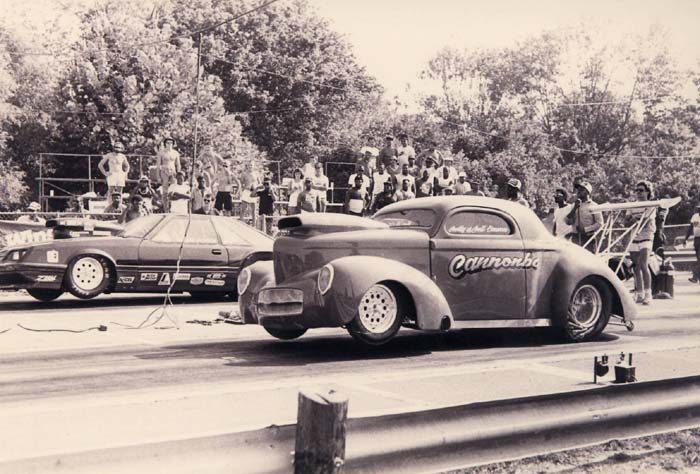
Throughout the Southeastern United States, many eighth-mile tracks, especially those in the Carolinas, booked in the IHRA’s mountain motor Pro
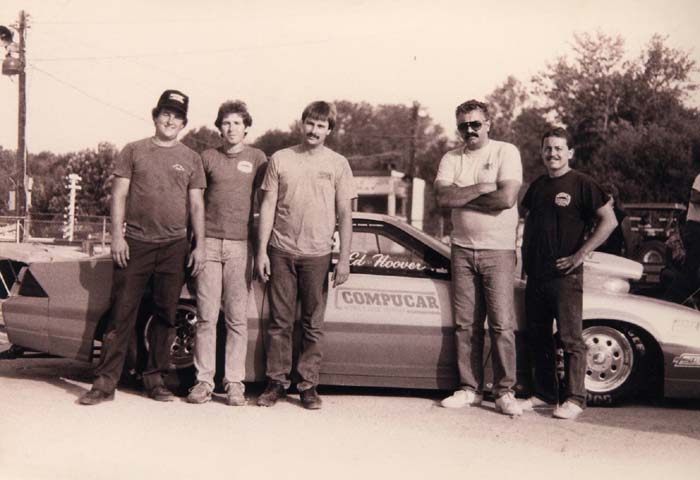 Let the record reflect that Ed Hoover won the first of the Quick Eight shootouts at Shuffletown Dragway in Charlotte, NC.
Let the record reflect that Ed Hoover won the first of the Quick Eight shootouts at Shuffletown Dragway in Charlotte, NC.
Stockers and Alcohol Funny Cars for match races. When the local races began to run quicker and put on a better show than the aforementioned entities, some of the promoters, namely the ones around Charlotte (NC) and Orangeburg (SC) began to offer these teams guaranteed money to withdraw from the bracket race competition and race against a similarly prepared entry.
The intuitive nature of these promoters led them to believe they had stumbled upon something and that if two put on a great show, then eight would be simply awesome. Instead of paying the individual appearance fees, these track operators, offered up decent purses for Quick Eight action.
Top Sportsman was their outlet to run national events but small backwoods venues such as Shuffletown Dragway (Charlotte) and Orangeburg Dragway (SC) was their connection to run free and play before packed houses of rabid doorslammer fans.
Racers like Michael Martin, with his nitrous-injected late-model Corvette, and Blake Wiggins rolled to the line with their fast breed of drag racing machinery and the plume of nitrous the blasted into the Carolina sky was enough to whip the often overflow crowds into a frenzy.
Depending on whom you ask, the first of the Top Sportsman Quick Eights were contested either in Orangeburg or Shuffletown. On alternating Sunday afternoons you could see an eight-car field of Martin, Wiggins, Carpenter, Ed Hoover, Sonny Tindal, Walter Henry, Ed Wilson, Thomas Jackson, Tommy Mauney and a score of others.
The fever of the local competition migrated to the national event and at the urging of Mike Thermos, founder of Nitrous Oxide Systems, the IHRA fielded a Quick Four event, first in Milan, Mi., and later in Bristol, Tenn., during the season-ending Fall Nationals event.
Thermos remembers flying to the east coast to discuss the potential of a Quick Eight Top Sportsman event and those meetings proved fruitless. He had all but given up on the idea of racing these cars on a heads-up, no breakout basis when he said Jones approached him in Milan and gave his blessings to a four-car shootout on Saturday night.
"I had just about given up on doing anything," Thermos confirmed. "I had flown out several times to talk to Ted Jones and for one reason or another, those meetings never happened. I wanted to do a Quick Eight for the Top Sportsman cars on Saturday night. Finally he told me I could do the Quick 4 thing in Milan. Ted asked me if I was going to pay them and I said, I'd pay them $500 and that's when Ted sent me to the pits to make it happen."
The fans ate up that special Saturday night shootout and after that, it became apparent that if the racers built this style of cars, the attention would come.
Thermos also fielded another Quick 4 during the 1987 IHRA Fallnationals and that was the final race under the ownership of Larry Carrier.
WATCH QUICK EIGHT VIDEO FOOTAGE FROM SHUFFLETOWN 1988
One of the birthplaces of Pro Modified, Shuffletown Dragway in Charlotte, NC, was a training ground for many of the class' pioneers with their Sunday afternoon Quick Eight competitions. On any given Sunday in the late 1980s, you could see Charles Carpenter, Tommy Mauney, Scotty Cannon, Ed Hoover and Blake Wiggins just to name a few. Video by Scott Caudill. (Story continues after video)
THE MEDIA MAGNET
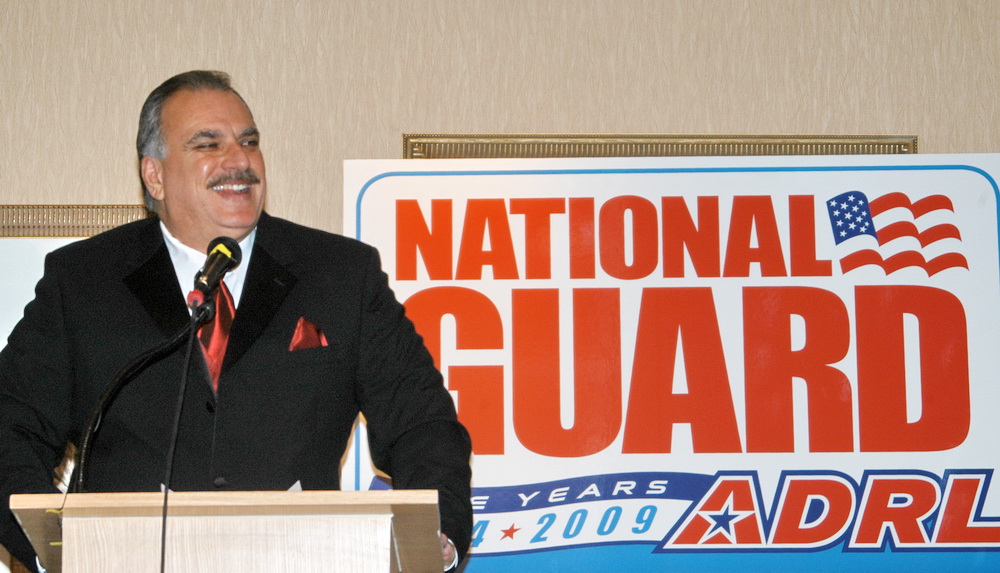 Noted drag racing historian and former IHRA national event announcer Bret Kepner believes that Pro Modified's movement to existence nearly mirrored the development of the Funny Cars in the 1960s.
Noted drag racing historian and former IHRA national event announcer Bret Kepner believes that Pro Modified's movement to existence nearly mirrored the development of the Funny Cars in the 1960s.
It was clear at the onset of the movement towards Pro Modified that the media would be a willing participant; especially the major drag racing rags SS&DI and the relatively new kid on the block DRAG RACING.
The early days had all the makings of second coming of the Funny Cars and because of that generated a lot of exposure on its own merits.
It’s a safe estimate that at least 95-percent of the two leading printed magazines of that era had at least one Top Sportsman-style, pre-Pro Mod feature story from 1983 through 1987. After 1987, the number rose to 98-percent with at least half of those with a cover story or blurb.
Kepner believes the early Funny Cars and the new advancing doorslammer revolution had their plusses and minuses in the drag racing media. The Funny Cars had more printed magazine outlets to show off their wares while the fast doorslammers had a much smaller magazine selection but had television and home video.
Like the Funny Cars, the pre-Pro Mods didn’t have to rely on a sanctioning body to produce their value. Any narrow dragstrip would suffice.
“The Funny Car revolution didn’t happen in either NHRA or AHRA, and completely outside of the auspices of a sanctioned national event,” Kepner explained. “That’s what Top Sportsman did. It repeated that history. It was ‘64 and ‘65 all over again.”
“Anybody, just like with Funny Car, could see this was going to be the next big hurrah. [Later] Duane Nichols [USSC] was the first to take advantage of it with a major media push. Everybody else was doing it already anyway.”
“It didn’t matter if the associations were paying attention, that’s what the race fans wanted to see,” Kepner said.
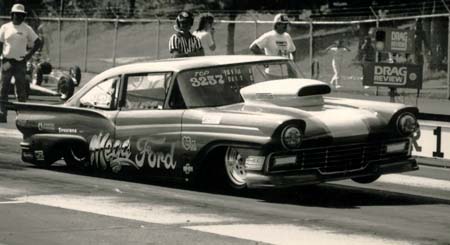 The lure of quick nostalgia bodied doorslammers left the fans craving for more participation outside of the standard Quick 32 confines of Top Sportsman.
The lure of quick nostalgia bodied doorslammers left the fans craving for more participation outside of the standard Quick 32 confines of Top Sportsman.
Pro Modified’s early push almost equaled that of the Nitro Funny Cars, in that both took nearly three years for full professional eliminator status once the major media push took root.
“We watched Ronnie Sox advance from a Z-11 Impala Super Stocker in 1963 and by 1966, he was behind the wheel of a lift-off bodied Barracuda,” Kepner recalled. “Top Sportsman evolved into Pro Modified nearly that quick. There was crazy stuff happening weekly. There was always something new and someone was always trying something different. The media had plenty to write about and they did.”
Everyone wanted a bit of the Top Sportsman doorslammers, even the magazines that didn’t normally write about drag racing. The specialty magazines ate up the uniqueness of the cars and bracket racing publications found a way to report on the 200-mile per hour missiles. After all, technically they were bracket cars on Sunday even if they did race heads-up as professionals on Saturday nights.
“Just like the Funny Car evolution, it went straight to big time,” Kepner said. “By the time, the IHRA introduced Pro Modified, they were already competing against three other series and there were more popping up each year. It was everywhere but in the NHRA.”
IN PART 2 - The World's Fastest Group, Milestones and the Billy Meyer Era (November 23)







































